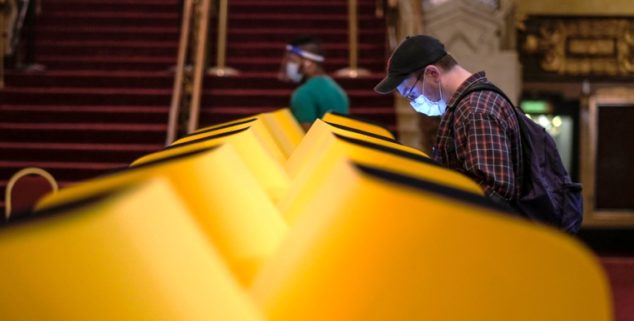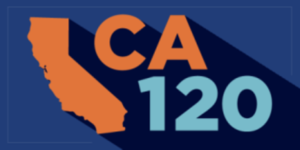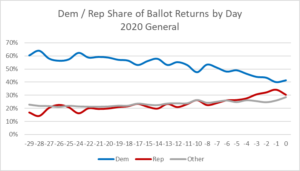Analysis
CA120: Reading the tea leaves as early votes come in
 A voter casts his ballot in the vote center at the Pantages Theatre in Los Angeles. (Photo: Ringo Chiu, Shutterstock)
A voter casts his ballot in the vote center at the Pantages Theatre in Los Angeles. (Photo: Ringo Chiu, Shutterstock)Ballots have been mailed to all 22 million California voters and many have already been returned.
As has been the pattern for the last several election cycles, this begins a month-long stretch where most voters will cast their ballots by mail or at in-person voting centers. Some will wait until Election Day and vote at the polls, but that is a declining portion of the electorate.
This primary election is different in that California is now in a permanent status as an all-mailed ballot state.
In the 2020 general election, we saw a flipping of the usual early voting patterns as Democrats and Republicans got polarized into early and late voting camps.
Unlike some other all-mail states, we still have abundant in-person voting options, but the state has made permanent a policy that more than a dozen counties had adopted by the 2020 primary election, and what COVID-era policies had spread statewide.
For the past decade, Political Data has been tracking the ballot returns, providing an opportunity for political consultants and candidates to read the tea leaves as the election develops. In some cases we have been able to see significant trends that supported what was seen in polling – such as the depressed Democratic turnout in 2014 and the outsized Democratic and Dem-leaning turnout in 2018.
We could also see some patterns developing based on how complicated the ballot was, such as when there were a large number of ballot measures, or when some voters were being faced with tough choices, such as a competitive presidential or gubernatorial primary.
In the 2020 general election, we saw a flipping of the usual early voting patterns as Democrats and Republicans got polarized into early and late voting camps – with Republicans vowing to vote at the polls because Trump was saying that voting by mail was fraudulent. Democrats, in turn, voted early to counter the Trump messaging, and embraced their own conspiracy theories, such as the U.S. Postal Service was trying to slow down ballots.
To prepare for another cycle of early vote tracking, let’s look at how the early vote has materialized in three past elections which exemplify the patterns that we have seen.
Standard Returns – 2018 primary and general
The primary and general elections in 2018 had very similar patterns, mirroring many earlier election cycles. The first ballots returned in this cycle were more heavily Republican than base registration rates would suggest. This is due to the faster rates of returns for older voters and homeowners, and lower rates for Latinos, young people and renters.
As can be seen below, the Democratic share of the early returns hovers mostly around 45-50% of returns, consistent with the Democratic rate of registration. Republicans are lower than Democrats at the 35% range, but overperforming their 25% share of registration.
There were a couple of instances of spikes and valleys in the 2018 general, but those were just Saturdays where we received few updates. If a small number of counties report on a Saturday and they are all rural counties, then you will see a temporary spike in Republican rates, and if it is just L.A. and Bay Area counties, you see a momentary spike in Democratic rates.
These spikes are a very visible reminder that some of what can impact these numbers are simply procedural.
This desire to not waste a vote on a presidential candidate who may drop out or not be competitive created a lower Democratic turnout in the earliest waves.
Particularly in the data from five-to-ten years ago, there were large differences in processes used by counties, and we could see something that looks like a signal of increased turnout. But we realized later that it was simply noise because of which counties reported that day, or because a big county was shifting to daily updates, instead of doing weekly updates in the prior election cycle.
Late Deciders – 2020 primary
The 2020 primary election saw an increase in the number of vote-by-mail voters, with more than a dozen counties switching to a by-mail voting system. The system is known as the Voters Choice Act, which blends mailed ballots with significant in-person voting options in the days leading up to Election Day.
But this election, more than any other recent example, shows the impact of a tight competitive primary election in which a segment of voters was holding on to their ballots.
Capitol Weekly polling at the time showed many Bernie Sanders voters casting early ballots, sure of their choices regardless of what was happening in other state primaries.
But many other Democratic voters were deciding between Elizabeth Warren, Pete Buttigieg and Joe Biden, or another candidate. They were hanging on to their ballots and watching these other primaries – including the South Carolina primary. which occurred the Saturday prior to the Tuesday California primary – and which saw Amy Klobuchar and Pete Buttigieg drop out of the race and endorse Biden.
This desire to not waste a vote on a presidential candidate who may drop out or not be competitive created a lower Democratic turnout in the earliest waves, with Republicans actually returning more ballots than Democrats in the first couple weeks of voting.
From the standpoint of the early vote analysis of previous elections, the 2020 General election was a massive outlier.
Then, once the Democratic contest began to settle, the vote on that side surged, and the relative share of the ballots cast by Republicans dropped.

A somewhat similar pattern was seen in the 2021 special recall election, with Democrats being told by the Newsom campaign that they could just skip the second question – not voting for a replacement – and just vote no on the recall.
This gave Democrats a permission structure for simply voting as soon as they got their ballots while Republicans were more likely to wait until the end – and, potentially, having lower turnout once it became clear the recall wasn’t going to be successful and the top vote-getting replacement was going to be a polarizing candidate in Larry Elder.
Flipping the Script – 2020 General
From the standpoint of the early vote analysis of previous elections, the 2020 General election was a massive outlier.
While Republicans became polarized against early voting, Democrats saw it as a cue to advance more early voting.
After many election cycles in which we had developed consistent early partisan voting patterns, dueling conspiracies by Democrats and Republicans shifted the landscape.
Among Republican voters here was a sudden shift in sentiment led by President Donald Trump and other prominent Republicans, including California Congressman Devin Nunes. They contended that a voter-fraud conspiracy was taking place, leading right-leaning voters to question casting their ballots by mail.
Republicans were told on Fox News, OAN, and other conservative media outlets that mailed-in ballots would be stolen or rejected by election officials, and that the only safe way to vote was to take their ballots directly to the polls.
While Republicans became polarized against early voting, Democrats saw it as a cue to advance more early voting. And Democrats developed their own conspiracy theories, including that the U.S. Postmaster was purposefully slowing down the mail system in order to make sure that ballots wouldn’t be received in time.
A social media trend developed with Democratic partisans racing to be the first among their friends to show they’ve cast their ballots, and Republicans were posting messages about duplicate ballots, the little holes in ballot return envelopes they said could be used to see who someone voted for, and other voter fraud claims.
Republicans have traditionally overperformed significantly in the early vote, regularly exceeding their rate of registration and far outpacing independents.
Democratic partisans developed a social media trend that encouraged liberal voters to be the first among their friends to show they’ve cast their ballots. Republicans, meanwhile, were posting cautionary messages about duplicate ballots, the little holes in ballot return envelopes they claimed could be used to see who someone voted for, and other voter fraud claims.
As can be seen in the graphic below, this polarization on voting methods created a massive Democratic lead in the early votes, with Republicans actually falling at or below the rate of returns for independent voters – something we have never seen before.
Republicans have traditionally overperformed significantly in the early vote, regularly exceeding their rate of registration and far outpacing independents. But in 2020, it was Democrats who were outpacing their rate of registration in early vote with early vote shares that were 15% or more than normal.

This move by Republicans in the 2020 General was rather shocking, as it literally discouraged their own voters from returning early ballots. That carries a very significant risk that their voters will lose their ballots, forget to vote, or get distracted by Election Day and simply never get to the polls.
It is a kind of unilateral disarmament that could result in a continued underperformance of an already declining political party.
What to expect in 2022
During the 2020 general election and 2021 recall election, California used a statewide by-mail voting system under pandemic-based executive orders. Subsequent to these two successful implementations, the state has now permanently transitioned to the new system.
The elephant in the room for early vote watchers is how Republicans and Trump-supporting independents use the vote-by-mail system.
For the 2022 primary we already have seen the state’s 22 million voters receiving ballots and we should be getting significant returns in the coming days.
As always, Political Data will be tracking these returns and posting daily updates with the partisan, age, ethnic and other makeup of the early vote. You can signup to receive a daily update for statewide returns, or returns for any legislative, congressional district, or even city and council elections here.
The elephant in the room for early vote watchers is how Republicans and Trump-supporting independents use the vote-by-mail system.
In polling conducted by Capitol Weekly prior to the 2020 general, we asked Republican voters if they were planning on voting by mail, or returning their ballot to a dropbox or to the polls. At the time only 37% of Republican likely voters said they would vote by mail, with 21% saying they would use a dropbox and 42% saying they would go to the polls.
Among Democrats surveyed this week, 60% say they will vote by mail, 34% say they will use a dropbox and only 7% say they will vote at the polls
In contrast, half of Democratic voters said they would vote by mail, 41% favored a dropbox and only 9% said they would wait to vote at the polls.
Heading into this primary we have asked voters the same questions, and we are finding similar results.
Only 44% of Republicans say they will vote by mail, while 22% are favoring a dropbox and 34% are saying they will vote at a local polling location. As in 2020, roughly half of Republicans do not believe their ballot would be safe if they mailed it in, with the greatest fear that someone is going to take their ballot and change their votes.
Among Democrats surveyed this week, 60% say they will vote by mail, 34% say they will use a dropbox and only 7% say they will vote at the polls. Nearly all (92%) of Democratic voters say they are confident that their ballot will be counted, with 77% “extremely confident.”
This year’s primary and general elections are unlikely to have the same attention or competitiveness – and Republicans can’t afford to have their ranks simply forget to vote.
If Republicans can get past the 2020 sentiment against vote by mail, the early returns would likely look like the 2018 primary, with Republicans outperforming in the early vote, Democrats holding their rate of registration, and independents coming in with slightly lower early participation.
However, if Republicans continue to carry this anti-mail-ballot sentiment, as the current polling suggests, this could be a very challenging election for their candidates and present a serious crisis for party leaders.
In this scenario, we should see an elevated Democratic share of the early vote throughout the early voting period, and any Republican strength could be limited to the very late and in-person voters.
In the 2020 General we saw the impact of this shift to later voting, and that was in an environment where every voter was inundated with wall-to-wall coverage of the election, and nobody was forgetting when the election was going to be held. It was also seen as incredibly competitive all the way to the finish line.
This year’s primary and general elections are unlikely to have the same attention or competitiveness – and Republicans can’t afford to have their ranks simply forget to vote.
Other important factors to consider include:
–Given the lack of exciting elections on the statewide ballot, we could see a relatively low turnout election, which could impact the relative rate of returns. The top of the ticket includes few household names, and even reporters are struggling to make something like the Attorney General or State Controller races interesting.
Most voters aren’t sitting on the edge of their seat waiting for the latest breaking news out of the State Controller or Attorney General race.
–With a higher rate of registration than any time in the last 100 years, we could have a lot more infrequent voters on the rolls, decreasing the percentage of voters who return ballots. However, the by-mail system likely increases turnout a bit, given how it reduces barriers to participation.
–The lack of any big cliffhanger elections, ones in which we are waiting for other states to vote, or where there are big competitive statewide contests, could allow for an earlier vote. There also aren’t a litany of confusing ballot measures on the primary ballot. Those traditionally have caused voters to wait while considering how they will vote.
–Residents of Los Angeles may vote a bit later given their historical late voting patterns, with some holding on to their ballots to decide in the mayoral contest. But most voters aren’t sitting on the edge of their seat waiting for the latest breaking news out of the State Controller or Attorney General race.
–The move by the Supreme Court to potentially end Roe v. Wade could have impacts on turnout among Democrats and other progressives, even if abortion isn’t expressly on the June ballot. Even if the wave of current attention abides, it is expected that the court could announce the decision before the June 7 primary election.
With all these caveats and unknowns it is important to take any early vote data with a grain of salt.
Remember, some prognosticators said that turnout in 2018 would be low because Trump wasn’t actually on the ballot – but for voter motivation on the left he may as well have been. We could see the same spike this year in the primary and general elections. Look for spikes in early Democratic voting or immediate surges if a decision is announced.
–There’s the hidden factor of the mechanics of the election systems. Over the past 20 years counties have made great strides in receiving and processing early ballots. We must always be careful to take early returns with a grain of salt — a few counties simply processing their ballots quicker can look to an outside observer like accelerated rates of voting.
As always, with all these caveats and unknowns it is important to take any early vote data with a grain of salt.
We could be seeing a large Democratic advantage in the early stages of the voting period – but that may not truly mean a massive overall Democratic turnout if they are simply cannibalizing their late vote. And any potential Republican loss in early voting could easily be made up in the last weekend and on Election Day.
Remember, these return patterns will also impact election night results. If, as has been seen in 2018 and many elections before, Democrats are the late returns and poll voters, we will see a “blue shift,” in which Democrats who were slightly behind on election night will begin winning races in the days and weeks after the election.
If the pattern is flipped, as our polling suggests, we would see a “red shift,” with Democrats who have leads on election night watching those advantages evaporate in the days and weeks after the election.
—
Editor’s Note: Paul Mitchell, a regular contributor to Capitol Weekly, is the creator of the CA120 column, vice president of Political Data and owner of Redistricting Partners.
Want to see more stories like this? Sign up for The Roundup, the free daily newsletter about California politics from the editors of Capitol Weekly. Stay up to date on the news you need to know.
Sign up below, then look for a confirmation email in your inbox.

Leave a Reply